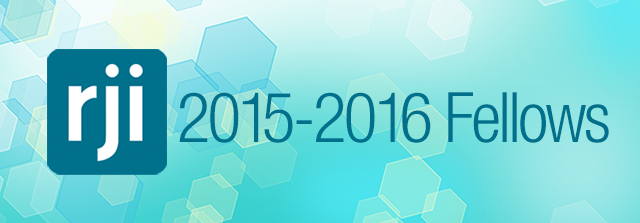
Tracy Clark’s take on 5 email news digests in the market today
Recently I wrote about 15 different mobile app news aggregators in the market today. A few of them — Shuffle, my company Reportory, and Apple’s upcoming news app — offer a daily email news digest of what you would find in the app. However, there are many others that just offer an email newsletter, which is what I’d like to focus on for this post. There are pros and cons to delivering customized news by email or app, or both.
According to a recently released email benchmarking study by IBM Silverpop, the average open rate in the U.S. is 20.7 percent and 21 percent worldwide. For the media and publishing industry, the U.S. average drops to 16.1 percent. Click-through rates averaged 3 percent for the U.S. and 3.2 percent worldwide. When looking again at just the media sector, these rates drop to 2.2 percent and 2.8 percent, respectively. Translation: For every 100 people you sign up for your U.S.-based news email, you can expect 16 to open your email each day and only two people to click on a link within your email. Yikes!
On the upside, the study found that the unsubscribe rate was lowest for the media sector, at 0.06 percent, in comparison to 0.13 percent worldwide. Thus, as a media organization, once you secure a registration, it’s less likely they will unsubscribe and more likely they will just delete four of five of the daily emails.
Why send out email newsletters if the engagement rate seems so low? Because daily emails are an easy way to stay at the front of a reader’s mind (whether they like it or not).
Could you rely on daily push notifications to remind mobile users to visit your news app? Not likely. A recent study from Kahuna shows that 60 percent of users opt out of push notifications. For those who opt in, the average engagement rate in the media industry is 19 percent. Taking our 100-person example, only 40 of them receive your push notifications, and only eight click them to open your app.
Now let’s add the two together: If you provide both a news aggregation app with push notifications and an email newsletter, you’re reaching 16 email readers and eight app readers versus just one or the other. Considering it costs as low as $10 per month to support email newsletter distribution (I use and highly recommend SendGrid), I can’t see why aggregators wouldn’t use both methods.
Below is my take on five daily newsletters I receive that aggregate general interest news. What is your favorite newsletter and why? Leave your feedback in the comments.
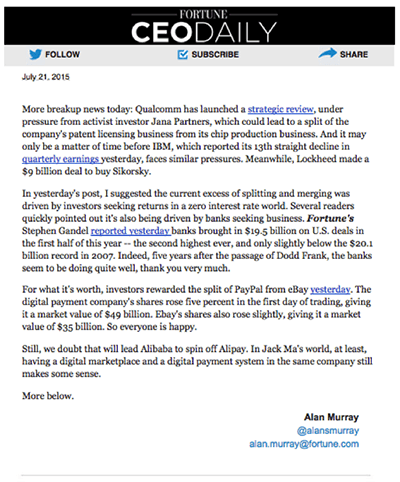
Fortune CEO Daily
Fortune offers five newsletters — I subscribe to both the CEO Daily and the Broadsheet, a newsletter focused on women business leaders. An undated media kit blurb promoted their newsletters being delivered to more than 122,000 readers, and Capital New York in July 2014 quoted Fortune’s TermSheet newsletter claiming 50,000 of those subscribers.
The CEO Daily is their “all-new daily email covering must-read business news curated by FORTUNE Editor, Alan Murray” and produced by John Kell. Per a note from Kell, it appears it was a rebranding of an existing Fortune Daily newsletter that was relaunched in the spring of 2015. Each newsletter is delivered at 7 a.m. ET and starts with a few paragraphs from Murray (or more likely Kell and quickly reviewed by Murray), then features a digestible amount of five or so “top news” articles followed by a few “around the water cooler” topics. From a sampling of newsletters this past week, on average 50 to 60 percent of the articles link back to Fortune. The remainder is a selection of articles from major outlets including The Wall Street Journal, The New York Times, Bloomberg and Reuters.
My Take: I like the personalized intro from Murray followed by a very consumable list of articles, much different from the daunting emails of Quartz, The Daily Beast and others. I like that they pull in other sources beyond Fortune and always note the source in the hyperlink so I know where they are sending me. They are very early in their work with newsletters, having launched many of them less than a year ago and their most recent one, Power Sheet, coming soon. I’m curious to see updated subscriber numbers and click rates on what type of traffic they are driving back to both their own site and other news sites.
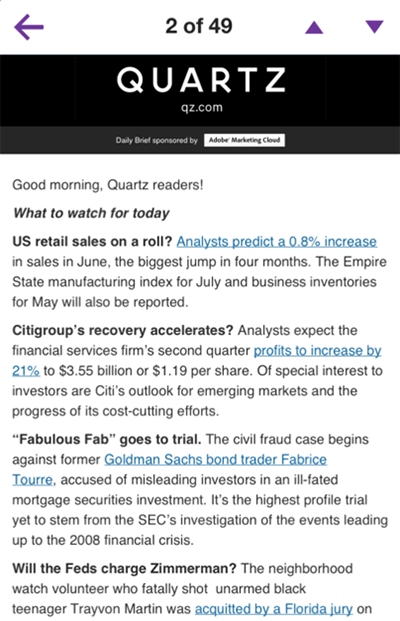
Quartz Daily Brief
Quartz Daily Brief is a once-a-day newsletter distributed at 6 a.m. ET. It includes five “what to watch out for today” articles, another five “while you were sleeping” entries, five “matters of debate,” five “surprising discoveries,” a “Quartz obsession interlude” and a sponsor post. It is a massively long email with dozens of links – 30 to 50 normally. About 25 percent of the links go to Quartz content, and the rest go to other news organizations. It never has images and always has the same template with content appearing in the same order.
News analyst Ken Doctor wrote that, as of February 2015, about 110,000 received the Quartz Daily Brief. As of June 2014, they had a 50 to 60 percent open rate, according to The Media Briefing.
My take: If their open rate is still topping 50 percent they are certainly doing something right. I’m curious what their click-through rate is and how it would compare to other newsletters with fewer links. I don’t like how their email template never informs me about the source of a link. It doesn’t display the source when I hover over it so I have to trust them that I will value and appreciate the source and the link destination, which sometimes I do not. I am very particular about which news sources I trust and will give my time, yet this newsletter decides those sources and links for me.
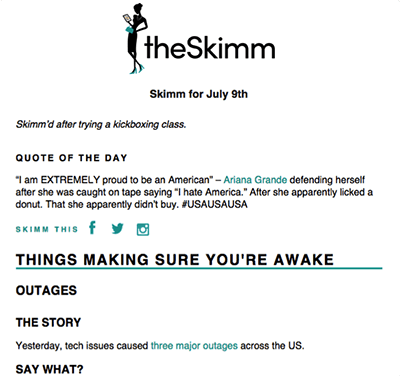
theSkimm
theSkimm was launched by former NBC news producers Carly Zakin and Danielle Weisberg in 2012. The daily newsletter is distributed at 6 a.m. ET. It includes a quote of the day, several editorialized news stories, and numerous promotions for its subscribers including share contests and public accolades for subscribers’ birthdays. The news stories are broken into three sections: the premise of the story, the longer version, and theSkimm’s take on the story. There are also several “repeat after me” sections that include news categorized within satirical topics such as “What to say when your friend forgets to pack mascara for your weekend trip.” Each email contains anywhere between 20 to 40 links.
In 2014 The Wall Street Journal noted that 70 percent of theSkimm’s subscribers were female, most between 18 and 33 years old. It raised an initial $1.3 million round in early 2014, followed by a $6.25 million round in late 2014, according to CNN. As of May 2015, AdAge reported they had 1.5 million active users per month with a 45 percent open rate.
My Take: Based on their numbers this type of newsletter obviously works for their following. However, I am a 30-year-old female and do not find the content or layout appealing. I don’t want their take on the news, nor do I find the “what to say when” section comical. Again, I am obviously the minority here in my opinion and I applaud Zakin and Weisberg for finding, and successfully monetizing, this niche.
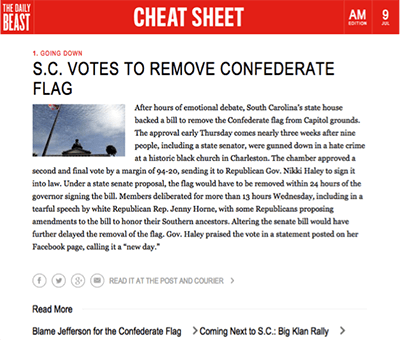
The Daily Beast
The Daily Beast offers two general email newsletters: the “Cheat Sheet” and “Daily Digest,” both delivered twice a day Monday through Friday. In February 2015, news analyst Ken Doctor noted that 600,000 people receive the Cheat Sheet, up from 182,000 a year ago. Each email contains around 10 top stories of the day curated from across the Web. For instance, a recent digest featured stories from The Post and Courier, The Associated Press, Deadline, The Hill, ESPN, Lloyd’s, BBC, The New York Times, Reuters and FIFA. Below that are several articles from The Daily Beast site, followed by articles from their partners.
My Take: They recently did a redesign of the email template, which I like a lot. Most entries have images and share functionality to increase engagement with the content. I find it funny that, at least in my Gmail browser, it cuts off below the 10 curated stories, never showing me their own articles or that of their partners unless I click to view it in a webpage (which I only did once out of curiosity to see the full newsletter). If a partner implies a paying advertiser, then if I were them I would be upset and request a higher spot in the email. This “top list” gets back to traditional editor-knows-best mentality of selecting my news such as Yahoo News Digest’s app, but you are always going to strike out and not be 100 percent relevant to anyone. This is the limitation of a generalized newsletter: I can’t tell them I have no idea who Lloyd’s is nor do I care about FIFA and ESPN news; give me more AP and The New York Times, which would make it more relevant to me and make me a loyal reader of their newsletter.
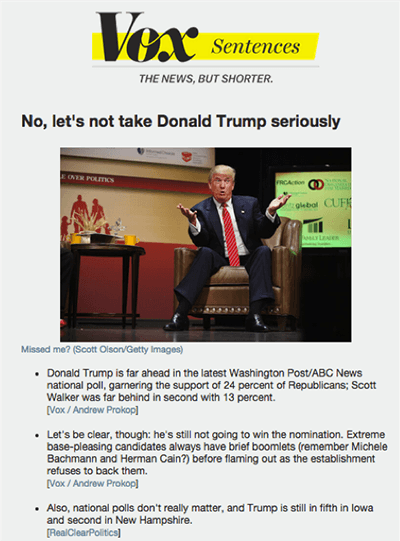
Vox Sentences
Vox Sentences is a newsletter sent weeknights at 8 ET. Both the layout and content is extremely different from other newsletters I have come across: The Vox newsletter aggregates sentences from multiple sources of a topic so it reads like one cohesive story. (It reminds me of Circa’s atomization approach to their now defunct app.)
Each newsletter has:
- Roughly three main stories; each story has five to 10 aggregated sentences.
- An assortment of approximately five “misc.” sentences.
- Another five “verbatim” quotes.
- Around four embedded advertisements.
- Anywhere from 30 to 50 hyperlinks. From a random sampling, I calculated 25 to 40 percent of its links go to Vox, and the rest go to a variety of national and obscure sources.
Nieman Lab ran a great feature on Vox Sentences in October 2014 when the newsletter first launched. “I don’t care if it drives traffic back to the site,” said Vox editor-in-chief Ezra Klein. “I care if the people who read it feel well served by it.”
In February 2015 they experimented with changing the layout from bullet point sentences to a prose format and were met with great distaste: “The votes are in, and man, you guys really did not care for yesterday’s Sentences format! It wasn’t even close. One hundred seventy-seven people wrote in, and 169 expressed a clear preference one way or the other (many thanks to the very sweet people who said they’d read it in any format). Thirty-two preferred the new version, while 137 liked the old one better.”
My Take: It is a long email with considerable scrolling when on a mobile device, which I suspect a majority of their readers are using when they receive this newsletter each evening. While I appreciate the experiment to send each night versus morning and aggregate sentences versus separate articles, I’m not a huge fan of this newsletter. I think it comes down to the fact that by 8 p.m. I have been consuming news and media for 12-plus hours and I am ready to unwind so I’m more likely to spend five minutes on Facebook than scrolling through this beast of an email. But many of their readers do enjoy the format and layout, so kudos to them for taking the risk of trying something different and building a loyal audience around it.

Comments